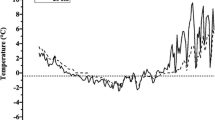Summary
Wood frogs (Rana sylvatica) were frozen to-2.5°C under five distinct cooling regimes to investigate the effect of cooling rate on survival. Frogs survived freezing when cooled at -0.16°C · h-1 or -0.18°C · h-1, but mortality resulted at higher rates (-0.30°C · h-1,-1.03°C · h-1, and -1.17°C · h-1). Surviving frogs in the latter groups required longer periods to recover, and transient injury to the neuromuscular system was evident. Some of the frogs that died had patches of discolored, apparently necrotic skin; vascular damage, as indicated by hematoma, also occurred. It is concluded that slow cooling may be critical to the freeze tolerance of wood frogs. Additional studies examined the effect of cooling rate on physiological responses promoting freeze tolerance. Mean glucose concentrations measured in plasma (15–16 μmol · ml-1) and liver (42–45 μmol · g-1) following a 2-h thaw did not differ between slowly- and rapidly-cooled frogs but in both groups were elevated relative to unfrozen controls. Thus freezing injury to rapidly-cooled frogs apparently was not mitigated by the presence of elevated glucose. Water contents of liver tissue, measured 2 h post-thawing, did not differ between slowly-cooled (mean = 77.6%) and rapidly-cooled (mean = 78.5%) frogs. However, the mean hematocrit of slowly-cooled frogs (48%) was significantly higher than that (37%) of frogs cooled rapidly, possibly owing to differences in the dynamics of tissue water during freezing.
Similar content being viewed by others
References
Bale JS, Hansen TN, Nishino M, Baust JG (1989) Effect of cooling rate on the survival of larvae, pupariation, and adult emergence of the gallfly Eurosta solidaginis. Cryobiol 26: 285–289
Baust JG, Rojas RR (1985) Review-insect cold hardiness: Facts and fancy. J Insect Physiol 31: 755–759
Claussen DL, Costanzo JP (1990) A simple model for estimating the ice contents of freezing ectotherms. J Thermal Biol 15: 223–231
Claussen DL, Townsley MD, Bausch RG (1990) Supercooling and freeze tolerance in the European wall lizard, Podarcis muralis, with a revisional history of the discovery of freeze tolerance in vertebrates. J Comp Physiol B 160: 137–143
Costanzo JP, Claussen DL, Lee RE (1988) Natural freeze tolerance in a reptile. Cryo-Lett 9: 380–385
Costanzo JP, Wright MF, Lee RE (1992) Freeze tolerance as an overwintering adaptation in Copes' Grey Treefrog (Hyla chrysoscelis). Copeia (in press)
Diller KR (1975) Intracellular freezing: Effect of extracellular supercooling. Cryobiol 12: 480–485
Layne JR, Lee RE (1987a) Biophysical and environmental parameters influencing ice formation in the body fluids of frogs. Cryobiol 24: 568–569 (abstract)
Layne JR, Lee RE (1987b) Freeze tolerance and the dynamics of ice formation in wood frogs (Rana sylvatica) from southern Ohio. Can J Zool 65: 2062–2065
Layne JR, Lee RE, Heil TL (1989) Freezing-induced changes in the heart rate of wood frogs (Rana sylvatica). Am J Physiol 257: R1046-R1049
Lee RE, Davidson EC, Layne JR (1990a) Extra-organ sequenstration of ice in the wood frog. The FASEB Journal 4: A551 (abstract)
Lee RE, Layne JR, Costanzo JP, Davidson EC (1990b) Systemic and organismal responses to freezing in vertebrates. Cryobiol 27: 643–644 (abstract)
Levin RL (1988) Osnotic behavior of cells during freezing and thawing. In: McGrath JJ, Diller KR (eds) Low temperature biotechnology: Emerging applications and engineering, contributions. BED-Vol. 10, Am Soc of Mech Engineers, New York, pp 177–188
Liebo SP, Mazur P (1971) The role of cooling rates in lowtemperature preservation. Cryobiol 8: 447–452
Lotshaw DP (1977) Temperature adaptation and effects of thermal acclimation in Rana sylvatica and Rana catesbeiana. Comp Biochem Physiol 56: 287–294
Mazur P (1963) Kinetics of water loss from cells at subzero temperatures and the likelihood of intracellular freezing. J Gen Physiol 47: 347–369
Meryman HT (1966) Review of biological freezing. In: Meryman HT (ed) Cryobiology. Academic Press, London, pp 1–114
Miller LK (1978) Freezing tolerance in relation to cooling rate in an adult insect. Cryobiol 15: 345–349
Morris GJ (1987) Direct chilling injury. In: Grout BWW, Morris GJ (eds) The effects of low temperatures on biological systems. Edward Arnold Ltd, London, pp 120–146
Pegg DE (1988) The nature of cryobiological problems. In: McGrath JJ, Diller KR (eds) Low temperature biotechnology: Emerging applications and engineering contributions. BED-Vol. 10, Am Soc of Mech Engineers, New York, pp 3–24
Schmid WD (1982) Survival of frogs in low temperature. Science 215: 697–698
Storey KB, Storey JM (1984) Biochemical adaptation for freezing tolerance in the wood frog, Rana sylvatica. J Comp Physiol B 155: 29–36
Storey KB, Storey JM (1988) Freeze tolerance in animals. Physiol Rev 68: 27–84
Author information
Authors and Affiliations
Rights and permissions
About this article
Cite this article
Costanzo, J.P., Lee, R.E. & Wright, M.F. Effect of cooling rate on the survival of frozen wood frogs, Rana sylvatica . J Comp Physiol B 161, 225–229 (1991). https://doi.org/10.1007/BF00262302
Accepted:
Issue Date:
DOI: https://doi.org/10.1007/BF00262302




